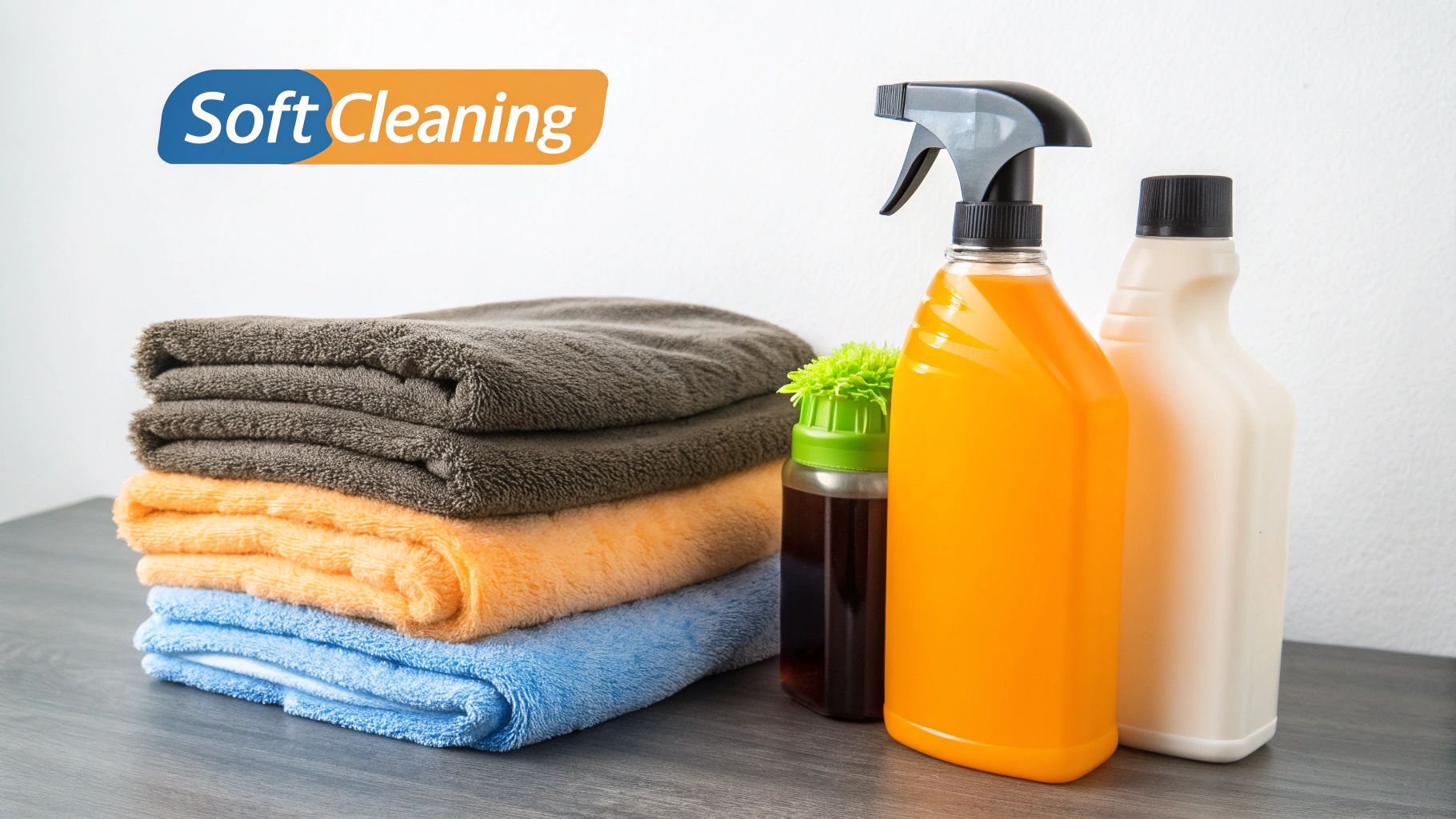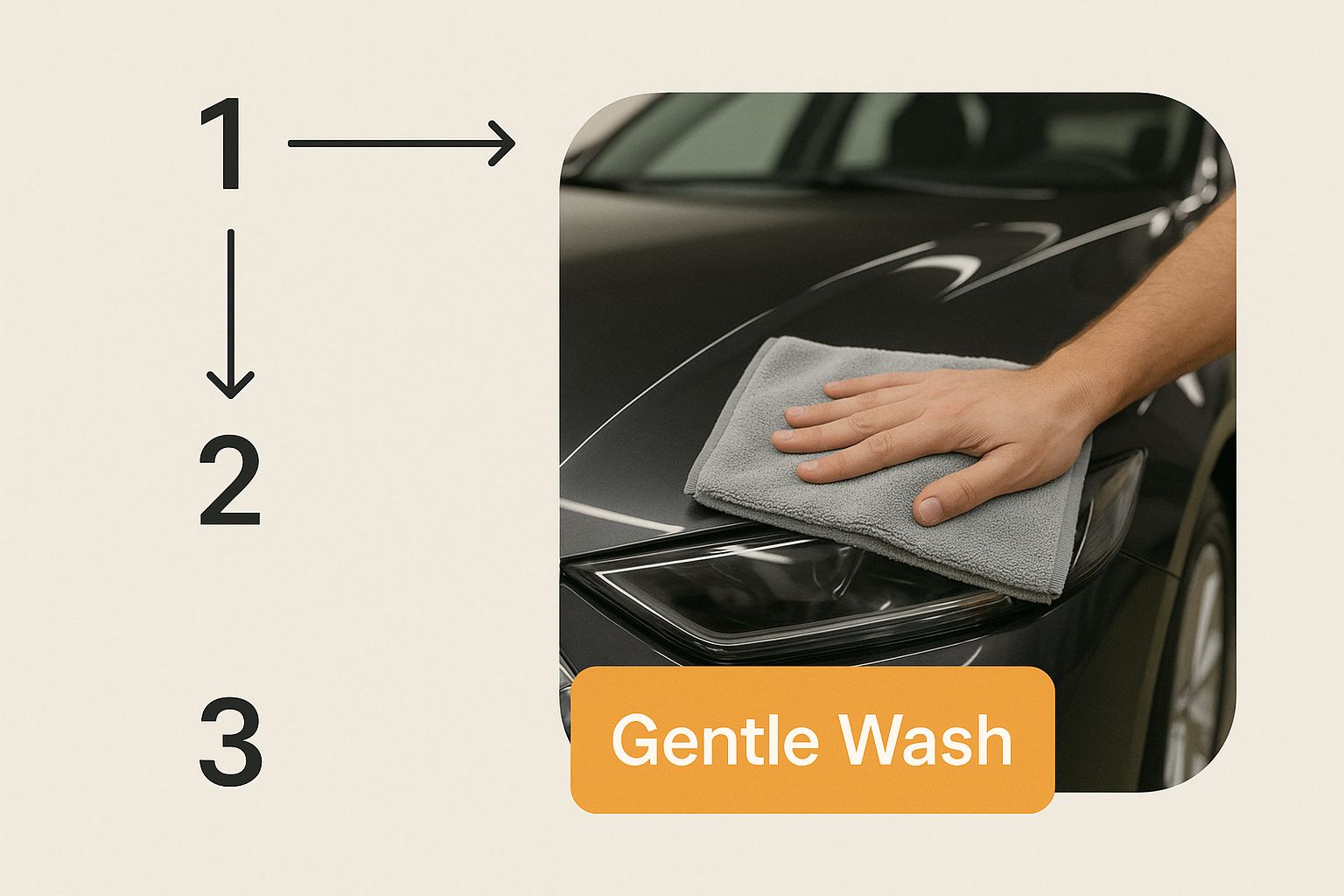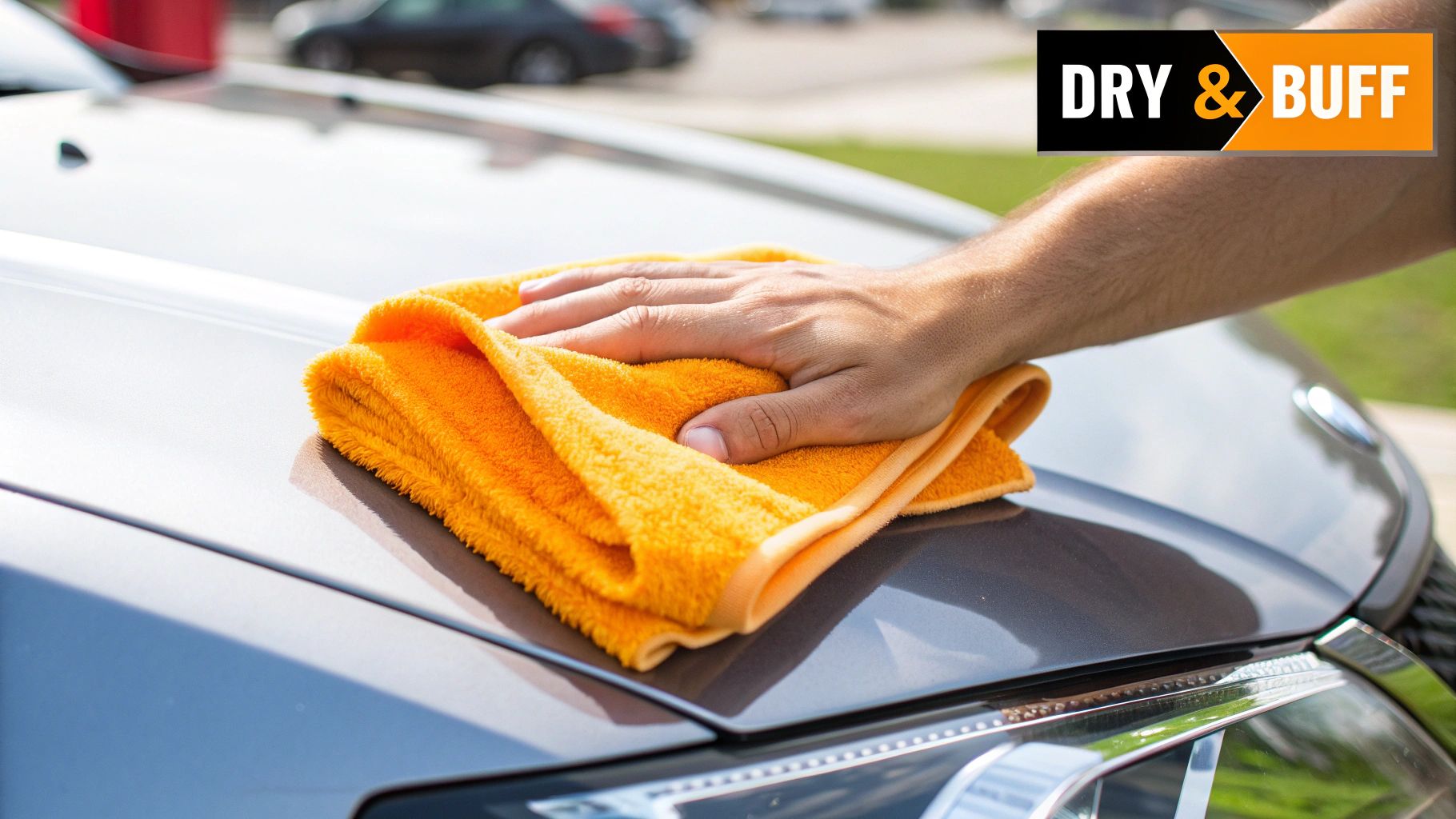If you want to keep your car's paint looking brand new, washing it with a proper microfiber towel is probably the single most effective change you can make. It’s the difference between a pristine, swirl-free finish and a paint job covered in fine scratches.
Forget those old cotton rags and bath towels. They just push dirt around, grinding it across your paint and creating those dreaded swirl marks. A quality microfiber towel, on the other hand, is designed to lift and trap those contaminants, safely pulling them away from your vehicle’s delicate clear coat.
Why Microfiber Is the Gold Standard for Your Car's Paint

Ever wondered if the type of towel you use really makes a difference? The answer is a resounding yes. So many car owners unknowingly damage their paint by grabbing an old t-shirt or a kitchen towel. At a microscopic level, these materials are surprisingly abrasive and do more harm than good by dragging grit across the surface. This is exactly how most light scratches happen.
Microfiber isn't just another cloth; it’s an engineered cleaning tool built specifically for automotive finishes. The magic is in its composition: a special blend of polyester and polyamide fibers that are split into strands far thinner than a human hair.
The Secret to a Scratch-Free Wash
When these ultra-fine fibers are woven together, they create a massive surface area with a slight positive charge. This charge acts like a magnet for dust and dirt, which are naturally negatively charged. Instead of just smearing grime around, the towel actively lifts and locks it deep within the fibers, keeping it far away from your paint.
Think of it this way: a cotton towel is like a snowplow, just pushing a pile of dirt from one spot to another. A microfiber towel is more like millions of tiny, gentle hands that grab onto every last speck of dirt and hold on tight.
The Bottom Line: The main reason to use a microfiber towel is its ability to lift dirt away from the paint. This simple action is what dramatically reduces the risk of creating the micro-scratches and swirls that dull your car's finish over time.
This cleaning power is why microfiber is a non-negotiable tool for professional detailers and car enthusiasts alike. It's not just hype—the market for these towels was valued at a massive USD 1.5 billion in 2024 and continues to expand as more people see the results for themselves. You can dive deeper into the growth of the microfiber towel market to see just how popular they've become.
Microfiber vs. Traditional Towels: A Quick Comparison
Not all towels are created equal. Here’s a quick breakdown of how microfiber stacks up against the old-school options.
| Feature | Microfiber Towel | Cotton Towel | Chamois |
|---|---|---|---|
| Absorption | Extremely high; holds 7-8x its weight | Moderate; gets saturated quickly | Good, but can streak if not fully wrung out |
| Dirt Trapping | Excellent; lifts and traps particles | Poor; pushes dirt across the surface | Pushes dirt; high risk of scratching |
| Lint | Lint-free | Tends to leave lint and fibers behind | Lint-free, but can become stiff when dry |
| Softness | Ultra-soft and plush | Can feel rough, especially when old | Smooth, but not soft or forgiving on paint |
| Durability | Very durable; lasts hundreds of washes | Breaks down over time; loses softness | Can tear or dry out and crack if not maintained |
As you can see, microfiber wins in every category that matters for protecting your car's paint. It’s simply the smarter, safer choice for anyone who cares about their vehicle's finish.
Setting Up Your Scratch-Free Wash Station
A great car wash doesn't start when water hits the paint—it begins with a smart setup. Getting organized beforehand is the secret to protecting your vehicle's finish from swirls and scratches. This isn't just about grabbing a random bucket and soap; it's about creating a system.
The cornerstone of that system is the two-bucket wash method. If you're serious about washing your car the right way with a microfiber towel, this technique is non-negotiable. One bucket is for your sudsy car shampoo, and the other is just for clean rinse water.
This simple separation is your best defense against dragging grit across your paintwork. The idea is to wash a panel, then dunk and agitate the dirty wash mitt in the rinse water bucket before you even think about putting it back into the clean, soapy water.
Your Essential Washing Gear
To pull this off correctly, you’ll need a few key pieces of equipment. Having everything ready to go makes the whole process smoother, safer, and way more effective.
- Two Buckets: It helps to label them "SOAP" and "RINSE" so you don't get them mixed up in the middle of the wash.
- Grit Guards: These are simple plastic inserts that sit in the bottom of each bucket. They knock dirt particles out of your wash mitt and trap them at the bottom, keeping that grit from getting back onto your paint.
- pH-Neutral Car Shampoo: Never use dish soap! It’s way too harsh and will strip off any wax or sealant you have. A dedicated car shampoo is designed to clean gently. If you want to take it a step further, a foaming car wash is a fantastic way to pre-soak the vehicle and loosen dirt before you ever touch it.
- Multiple Microfiber Towels: You can't do the job with just one. Keep your plush, high-pile towels for the paint itself. Have a separate stack of less precious towels for the really grimy areas like wheels, tires, and door jambs.
The entire goal is to isolate contaminants. Using two buckets and different towels for different jobs ensures the heavy grit you pull off the lower parts of your car never touches the delicate paint on the hood or roof.
One last pro tip: always wash your car in a cool, shady spot. If you work in direct sunlight, the soap and water will dry on the surface way too fast, leaving behind stubborn water spots and streaks. This one simple change makes a world of difference in the final result.
The Professional Two-Bucket Wash Technique
Alright, with your wash station all set up, it's time to get down to business and wash your car like a seasoned pro. The whole idea here is to follow a simple, disciplined rhythm that keeps dirt away from your paint. Forget everything you've ever learned about scrubbing in big circles—this is all about being methodical.
First things first, give the entire car a solid pre-rinse. Grab your hose and spray from the top down, knocking off as much of that loose dust, dirt, and grime as you can. You'd be surprised how much abrasive junk this one step removes before your wash mitt even makes contact.
Mastering the Two-Bucket Rhythm
Once the car is rinsed and still wet, you can start washing. The golden rule is to always start with the cleanest parts first. Think roof, hood, trunk, and the upper sections of the doors. You want to work your way down, saving the grimiest parts for last. This simple habit prevents you from dragging all that heavy gunk from the lower panels all over your nice, clean surfaces.
The actual technique is what separates a good wash from a great one. It's a simple back-and-forth process:
- Load Up: Dunk your plush microfiber mitt into the SOAP bucket and let it soak up all that rich, lubricating suds.
- Wash a Section: Gently glide the mitt across a small area, like one door or half the hood. Always use straight, overlapping lines. Wiping in circles is the fastest way to create those dreaded swirl marks in your paint. Let the suds do the work, not muscle.
- Rinse the Mitt: This is the most critical part of the whole process. Before you even think about getting more soap, plunge that dirty mitt into your RINSE bucket. Really swish it around against the Grit Guard at the bottom—you’ll see the dirt release and fall safely to the bottom of the bucket.
- Reload and Repeat: Squeeze the excess water out of the clean mitt, then head back to the SOAP bucket for a fresh load of suds. Now you’re ready to move to the next panel and do it all over again.
This method ensures you're only ever touching your paint with a clean, soap-filled mitt.

As you can see, it's all about a gentle, deliberate approach that lets the microfiber and high-quality soap do the heavy lifting, protecting your paint from harm.
Pro Tips for a Flawless Finish
Want to really dial in your results? A few extra habits can make a huge difference. These little details are what separate a quick wash from a true detail. If you're looking for more ways to perfect your process, check out these easy tips for a spotless finish at home.
Expert Tip: Never, ever use the same wash mitt on your paint that you use on your wheels. Your wheels and the lower rocker panels are magnets for the nastiest, most abrasive brake dust and road grime. Keep a separate, dedicated mitt just for those areas to avoid dragging those damaging particles all over your car's clear coat.
By sticking to this disciplined method of washing your car with a microfiber towel, you’re doing more than just getting it clean—you're actively preserving its value and finish. It’s a simple system that quickly becomes second nature and pays off with professional-level results, every single time.
You've just spent all that time carefully washing your car, so the last thing you want to do is ruin all that hard work in the final step. A sloppy drying job can instantly cover your clean paint in swirl marks and ugly water spots.
Getting that perfect, streak-free shine all comes down to the right towel and the right technique.
The Secret to a Flawless Finish: The Right Drying Towel
If you're still using an old leather chamois, it's time for an upgrade. The best tool for the job, hands down, is a large, high-quality waffle-weave microfiber towel.
Its unique pocketed texture is designed to soak up an incredible amount of water on contact, which means you're making fewer passes over your paint. This is why microfiber towels absolutely dominate the car care scene, making up over 70% of the car wash towel market. Experts and enthusiasts agree they are the safest and most effective option, as backed up by market analysis reports on car care tools.

Pro-Level Drying Techniques
There are a couple of tried-and-true methods that pros use to dry a car without scratching the paint. I recommend trying both to see which you prefer.
-
The Blotting Method: This is the safest way to dry your car, period. Take your large waffle-weave towel, spread it out completely, and lay it across a panel like the hood or roof. Lightly pat the surface of the towel, letting it absorb the water. Then, just lift it straight up, wring it out if it’s saturated, and move on to the next section. No dragging means virtually zero risk of swirling.
-
The Towel Drag: This works beautifully on big, flat surfaces. Hold two corners of the open towel and gently glide it across the panel in one smooth, straight motion. You don't need to apply any pressure—let the weight of the towel do all the work.
My Go-To Tip: Before you dry a panel, give it a quick mist with a good drying aid or a quality quick detailer spray. This adds a bit of lubrication that helps the towel glide like it's on ice, minimizing friction and boosting that just-waxed gloss.
Stick with a quality microfiber and a gentle touch, and you'll be left with a brilliant, spot-free finish every single time.
Taking Care of Your Microfiber Towels
Think of your microfiber towels as an investment in your car's paint. Taking care of them isn't just about cleaning them; it's about making sure they continue to perform safely for years to come.
Tossing them in the wash with your regular clothes is one of the worst things you can do. It's a surefire way to clog up those delicate fibers with lint and detergent residue, which basically turns your soft, safe towel into a piece of sandpaper on your next wash.
The golden rule is simple: always wash microfiber towels separately. Those tiny fibers that are so great at grabbing dirt off your car are just as good at grabbing cotton lint from a t-shirt. This single step prevents the kind of cross-contamination that can cause swirls and scratches.
The Right Way to Wash and Dry
For the best results, you'll want to stick to a specific routine.
- Choose the right soap: A dedicated microfiber detergent is ideal, but a gentle, dye-free liquid detergent will also work in a pinch. Steer clear of powdered detergents; they often don't dissolve completely and can get caked into the fibers.
- Absolutely no fabric softener or bleach: This is critical. Fabric softener clogs the microscopic pores of the microfiber, completely ruining its ability to absorb water. It basically coats the fibers and makes them useless. Bleach, on the other hand, will just break them down and make them brittle.
Pro Tip: I always run a second rinse cycle when I wash my towels. This guarantees every last bit of detergent is flushed out, leaving them perfectly clean and ready to deliver a streak-free finish.
For a deeper dive, our full guide on washing microfiber car towels breaks down the entire process.
When it's time to dry, remember that high heat is microfiber's worst enemy. It can actually melt the synthetic fibers, leaving them hard and scratchy. Always tumble dry on the lowest possible heat setting.
Even better? Just let them air dry. It might take a bit longer, but this gentle approach ensures your towels will stay soft and safe for literally hundreds of washes, protecting your car's finish every single time.
Got Questions About Microfiber Washing? We've Got Answers.
Even after you’ve got the basics down, a few questions always pop up. It’s totally normal. Getting that perfect, swirl-free finish is a craft, and refining your technique is part of the fun. Let's clear up some of the most common questions I hear from fellow car enthusiasts.
So, how many towels do you really need? This is probably the number one question. For a typical sedan or SUV, I always recommend having at least three plush towels just for the paint. You'll also want one dedicated waffle-weave towel for drying, and another two or three general-purpose towels for the dirtier jobs like wheels and door jambs.
Keeping these towels separate is non-negotiable. It’s the golden rule for preventing cross-contamination.
Can I Use the Same Towel for Paint and Windows?
I get this one a lot, and the answer is always a hard no. It’s tempting to cut corners, but trust me, it’s a bad habit that will come back to haunt you.
Your paint towels can easily pick up tiny bits of wax or sealant. If you then wipe your windows with that same towel, you're just smearing that residue all over the glass, which leads to frustrating streaks that are a real pain to buff out.
Always grab a dedicated glass towel—a low-pile or waffle-weave microfiber works best here. It's the only way to guarantee a perfectly clear, lint-free finish.
Expert Tip: The secret to a scratch-free wash is simple: prevent contamination at all costs. Having specific towels for paint, glass, wheels, and drying is the single most important thing you can do to protect your car’s finish and get those pro-level results right in your driveway.
What about towel color? While you don't have to, using different colors is a brilliant little hack. For example, you could use blue for paint, green for glass, and black for wheels. This simple visual system makes it almost impossible to accidentally grab your gritty wheel towel and drag it across your paint. It’s a cheap insurance policy for your car’s clear coat.
Ready to elevate your wash game? The SwiftJet Car Wash Foam Gun transforms a regular garden hose into a serious foam cannon, lifting away grit and grime before you even lay a mitt on the car. Grab one and see what a difference a proper pre-soak makes. Check it out here.
